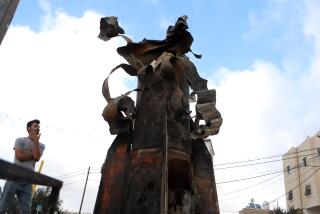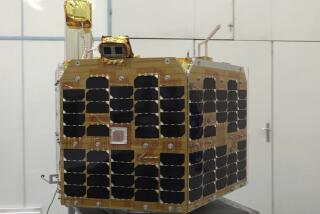Missile Test Points Up Iran’s Arms Abilities
WASHINGTON — Iran test-fired an intermediate-range ballistic missile Wednesday, a sign that the Islamic Republic is moving closer to the ability to hit Israel or Saudi Arabia with a weapon that can deliver explosive, chemical or nuclear warheads, U.S. officials said Wednesday night.
The missile appeared to be a model known as the Shehab 3, an Iranian version of a North Korean model called the No Dong, which has a range of about 800 miles, U.S. officials said. That range would include Israel and most of Saudi Arabia and Turkey.
U.S. intelligence officials and Israel have been reporting for some time that Iran--with Russian help--has been trying to acquire intermediate-range missiles. The Clinton administration has been taking cautious but accelerating steps toward improving relations with Iran but at the same time has been warning that Tehran is continuing its efforts to acquire ballistic missiles and nuclear or chemical warheads.
Until late last year, intelligence reports generally said Iran was at least two years and probably more away from being ready to test a missile. But late in 1997, U.S. intelligence agencies advanced the predicted schedule and forecast that a test could come within a year--a forecast that inspired Congress to pass legislation imposing sanctions on Russian companies that assist the Iranian program.
President Clinton vetoed that bill, arguing that Russia has begun to crack down on missile technology exports to Iran.
Congressional supporters of developing a U.S. antimissile defense system also sponsored legislation to increase funding for a joint U.S.-Israeli missile defense system known as the Arrow.
Last week, a bipartisan group known as the Rumsfeld Commission after its chairman, former Defense Secretary Donald H. Rumsfeld, warned specifically that Iran, along with North Korea, posed a more imminent missile threat than even the latest U.S. intelligence assessments said. Such countries are still some years away from acquiring long-range missiles able to hit the United States, that report said, but missiles such as the Shehab could inflict major damage on U.S. allies such as Israel or on U.S. troops in South Korea or the Persian Gulf region.
North Korea, isolated and impoverished, has said that it intends to continue its long-standing practice of selling missiles and missile technology to whoever will buy the weaponry.
Iran’s test at a remote desert site Wednesday “confirms the concern we’ve had for a long time, that North Korea is selling this stuff and countries like Iran are buying it,” a senior U.S. official said.
He described the missile as “basically an extended-range Scud,” the Soviet-designed missile used by Iraq during the 1991 Persian Gulf War.
More to Read
Sign up for Essential California
The most important California stories and recommendations in your inbox every morning.
You may occasionally receive promotional content from the Los Angeles Times.










